Pune. 22 January 2020. True to their motto ‘Sarvatra’ The Bombay Sappers have been called upon in aid of civil authorities .They have brought succor to the suffering populace with their ingenuity, innovativeness and courage.
Koyna -1960
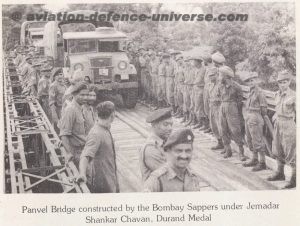
On 11 September 1960, a severe earthquake rocked Koyna and completely destroyed Koyna Nagar. A contingent from the Bombay Sappers led by Maj S S Bansode was sent to the site to salvage public property and buildings, and to help dismount the hoist tower that was perched precariously over the Koyna Dam. In this instance, the Sappers also assisted the police in controlling the law and order situation that erupted. 1993: Latur Earthquake A total of nine columns comprising three Officers, nineteen Junior Commissioned Officers and three hundred and forty one Other Ranks from the BEG Centre were inducted to assist in relief operations in Latur and Osmanabad districts of Maharashtra between September to October1993. One officer and a Non Commissioned Officer were awarded COAS Commendation Cards in recognition of the commendable service.
Kutch – 2001
108 and 111 Engineer Regiments of the Bombay Sappers were deployed as part of a rescue team to assist in earthquake relief measures, when a massive earthquake struck the Kutch region of Gujarat in January 2001. The Sappers were involved in a number of tasks including rescue of people buried under the debris, extrication of dead bodies, clearance of debris, restoration of lines of communications, recovery of valuables, restoration of electric installations and services, provision of safe drinking water and restoration of existing water supply, and establishment and management of emergency camps and schools.
Kashmir -2005
A massive earthquake struck the Kashmir valley on 8 October 2005. The earthquake was measured at 7.6 on Richter scale, and the epicenter was approximately 26 kms south west of Tangdhar, near Muzaffarabad. Army and civil dozers were pressed into service to clear roads and tracks leading to affected areas and clearing of debris. Joint rescue patrols were able to reach almost all the remote affected villages within 24 hours of the quake. 111 Engineer Regiment was in the fore front of the rescue and relief, debris clearance and rehabilitation work.
Bombay Goa Highway – 1958
In 1833, a 354 feet bridge with masonry piers was constructed on the Bombay-Goa highway. In 1958, heavy floods demolished four of its piers leaving a gap of 150 feet. 624 Army Troops Engineers were tasked to construct a bridge to span the gap. A 180 feet Bailey Bridge was launched and a triple storey was added by manually lifting the panels into position. The total building time was only 28 hours, including the time for off-loading and providing the wearing surface. The operation was named ‘Op Bandhan ‘ .
Bhakra Dam – 1959
During the construction of the Bhakra dam in 1959, the right side diversion tunnel had been carved in a region of soft sandstone creating real danger of the dam collapsing under great pressure. 624 Corps Troops Engineers consisting of 18 and 19 Field Companies and 46 Field Park Company were called to solve the problem which they did by dropping boulder crates weighing 10 tons at the mouth of the tunnel to block the flow of water. 20,000 crates were dropped ‘round the clock’ for 4 days and the danger averted. All credit goes to Col P L N Choudary for successfully executing ‘Operation Madhuri ‘ , who led the Sappers and saved the dam.
Khadakvasla Dam – 1961
‘ Operation Bagla Bhagat ‘ was launched when the Khadakvasla Dam burst its banks in 1961 flooding Poona city, the Bombay Sappers were at hand to assist the civil administration. When the floods receded, the Sappers worked non-stop to demolish unsafe buildings, clear debris and slush, and provide temporary accommodation to displaced people. They also restored water supply temporarily by rapidly building a canal to divert water back to the reservoir. Col J V P Braganza, Commandant of the Bombay Engineer Group and Centre, who was in charge of all operations of flood relief, was awarded the VSM. Same year due to heavy floods in the area of the Mahanadi delta in Orissa, about 150 villages were inundated and a large population marooned. 235 IWT Company using folding Craft rescued 960 marooned people.104 Engineer Regiment carried out flood relief operation in Binaguri in 1966-67. In August 1972, 411 Parachute Field Company moved to Bharatpur for flood relief operations. They rescued and evacuated 16 Italian tourists from Golbagh Palace in Bharatpur, and 61 tourists from Fatehpur Sikri. In all, 600 people were rescued. In September 1972, when Uttar Pradesh in general and Lucknow in particular, were seriously threatened by erosion of the protective bund on the River Gomti, Lt Gen P S Bhagat, VC ,the then Army Commander , Central Army personally directed operations aimed at strengthening the bund, evacuation of civilians in boats and airdropping food to marooned people, saving the city from a major disaster. In 1978 during Operation ‘Narial Pani ‘ 201 Bomb Disposal Company was involved in the evacuation of the civil population and distribution of rations and medicines. During 1978 heavy floods in the River Indus caused breaches at 22 different places inundating villages and cutting off supplies.107 Engineer Regiment took up the work of evacuating the civil population, anchoring bridges, building cableways, repairing damaged roads and buildings, and bringing in essential supplies. A hospital was also constructed.106 Engineer Regiment took part in flood relief operations code named
Anandpur Sahib – 1988
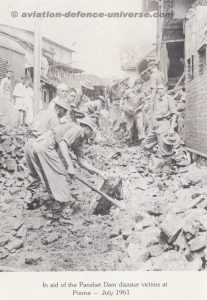
Op ‘Madad Panama’ near Anandpur Sahib (Punjab) in 1988, rescuing marooned people from Harse Bela, Gojpur and Hajiwal Villages.114 Engineer Regiment evacuated approximately 19,000 marooned civilians from various locations of Patiala during Op ‘Jaltarang’ in 1993. In addition, a number of medical relief camps were organized. Sub Shamsher Singh was awarded the Sena Medal posthumously, for rescuing marooned people. During Operation “Maroon Aid” 411 Para Field Company provided aid when Kalindi Express rammed into a static Purshottam Express at Ferozabad, in 1995. The Super troopers led by Lt Rajeev Kaul were the first to reach the site of the accident, and were given the responsibility of coordinating all aid that was being provided by the Para Brigade. The aid was in the form of extricating trapped people which later transferred into extricating the dead from the debris. In 1996, 109 Rapid Engineer Regiment and other engineer units sent relief columns to the flood affected districts of Puri, Cuttack, Jagpur, Jagatsinghpura and Kenjrapara in Orrisa, evacuating 6,693 persons and distributing 455 tons of relief material.Yet again in Orissa Cyclone Relief during October-November 1999, after the cyclone had struck Orissa, one column of 117 Engineer Regiment was airlifted to provide rescue and relief operations to the affected areas. It restored road communications, transported civilians to safer areas and distributed medical supplies to the affected population.103 Engineer Regiment provided relief operations in heavily inundated areas of Allahabad city in September 2000, evacuating 6,600 people. A bridging column comprising of an Officer, 3 JCOs and 75 Other Ranks, along with two sets of bridging equipment, provided relief and rescue to people affected by the Tsunami on the Kerala coast. Rafts of 18 and 24 tons, deployed for distribution of relief and medical assistance, helped in providing timely assistance to the affected. The Bombay Sappers were involved in a number of rescue operations throughout Maharashtra in July 2005, when people from all over the state were threatened by heavy rains. The Sappers evacuated 200 people including 36 women and 20 children in Pune District, and 80 people in Aurangabad District. They distributed medical supplies and dry rations in Mumbai and because of timely precautions , they secured the lives of over 5900 people threatened by release of waters from the Koyna dam.
Bombay Port Trust
When 6,500 workers of the Bombay Port Trust went on strike for higher wages in December 1947, the Bombay Sappers were called to execute all port duties. 6 Docks and IWT Group led by Lt Col Skinner operated dock gates, pumping stations, sluices, cranes, hoists, workshops, motor transport, bunkering and discharge of ships. In all, 75,000 tons of cargo were handled in five weeks and exports increased were higher than the pre – strike period. In 1974, during the railway strike in Bombay and Baroda, the Bombay Sappers manned substations, workshops and electric lines, as well as the power house at Barsal and the depot at Baruch. Railway engines were repaired and sabotaged electric lines recommissioned under operation “Rishab Vahan”. 235 IWT Operating Company of the Bombay Sappers handled the sophisticated oil machinery during the Port Trust strikes at Calcutta in 1950, 1974 and 1978, and during the oil blockade in Assam in 1980 -81. In 1992-93 two columns of Bombay Sappers comprising 4 Officers, 8 Junior Commissioned Officers and 209 Other Ranks were assigned the task of maintaining peace and normalcy on the Western Express Highway in Bombay when communal riots erupted in the city after the demolition of the Ayodhya mosque. Miscellaneous Services • Maintenance of electrical services during a strike at OBRA • Maintenance of electrical services during Pirand in 1972 • Street patrolling during communal riots in Aligarh • Search for the black box of the ill fated Vayudoot Aircraft at Ujjaini Dam in 1990 • Handling of heavy equipment during the Bombay Dockyard workers strike in 1989 • Unexploded bombs disposal by the Bomb Disposal units in Madras 1997, assistance to police post Bombay Blasts 1993, and Shells destruction at Ghaziabad in 2005.
Oil Blockade in Assam – 1980
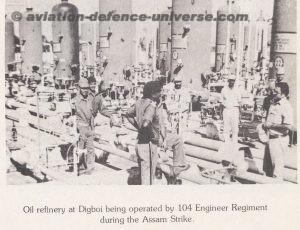
In 1980, during the Special Services Oil Blockade in Assam, Maj Gen (Hony) S C N Jatar was responsible for restoring the oil supply to full capacity in a short period of time. He did so to the satisfaction of all. During 1980,104 Engineer Regiment was deployed under Op ‘Indra Vajra’ to operate Hazira oil fields at Galeta, Rudrasagar, Lakhwa and Hazira, when ONGC workers went on strike. More than 5,000 kiloliters of oil was produced and pumped and 70 oil wells activated.
Op ‘Sadbhavana’
Op ‘Sadbhavana’ was launched by the wherein the local population decide their requirements and place their demands to the Government. Winning the hearts and minds of the people being the focal point in ‘Sadbhavana’. Under this scheme, the Bombay Sappers Regiments worked day and night and constructed Schools, Vocational Training Centers, Army Goodwill Schools and Women’s Empowerment Centres, Community Development Centres, water supply and electrification of selected villages on the Line of Control at various places .In addition, the Bombay Sappers were also involved in the construction of large underground bunkers for the civil population in villages affected by trans LC firing, construction of playgrounds in various villages, adoption of villages for social development work such as renovation of schools and dispensaries, and assistance to the Public Works Department for the construction of roads in remote areas. Operation ‘Apricot’ During the continued drought in Ladakh for three consecutive years, 21 (VC) Field Company in April 2001 was entrusted with the task of installing high discharge pumps, in order to save the apricot trees from extinction.
Bridges in Himachal Pradesh -1997
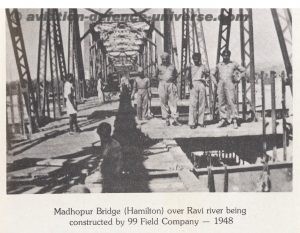
On 11 August 1997, communications on NH 22 were severely disrupted due to a cloud burst at Wangtu in Himachal Pradesh. Approximately three kms of NH 22 along with four kms of River Satluj were blocked, due to which a lake was created approximately 1500 metres long and 300 metres wide. 107 Engineer Regiment was tasked to establish communications and construction of a 400 feet Bailey Suspension Bridge (BSB) on River Satluj. Two 18 ton KruppMann rafts and five boats were pressed into service to ferry Army personnel, civilians and various kinds of loads across a 10,000 metre long water way.
The ‘Shatrujeet Bridge’ was completed on 27 June 1998 and was inaugurated by Professor P K Dhumal, Chief Minister of Himachal Pradesh, on 29 June 1998. The Chief Minister in his inaugural speech was all praise for the Shatrujeet Engineer Regiment. The bridge was constructed with only 6.97 metres back space and on the right bank down stream side, it had only 1.75 metres of side space.
The Engineer Regiment under 2 Mountain Division was tasked to launch three Class 18 Kruppmann Bridges of approximately 100 metres each, over the fast flowing waters of Lohit River in Wangtu, from the months of October to March every year. These bridges are used for winter stocking as well as maintenance of lines on communication. In 1991, Maj D K Vishnoi of 117 Engineer Regiment won the Harkirat Singh Gold Medal for devising the ‘Minimum Thrust Technique’ for the launching of floating bridges in fast flowing rivers.
Even though critical repair of the 360-feet long class – 24 Bailey Suspension Bridge at Sholding Khud on NH-22 was carried out by the 116 Engineer Regiment in 1995, the bridge was completely done by the Regiment in November-December 1996. 268 Engineer Bridging Regiment carried out construction of three Bailey Suspension Bridges on the Jiri, Makru and Barak rivers under ‘Project Sewak’, in October 1969.In June 1989, 370 Field Company of 101 Engineer Regiment launched a 160 feet double storey Bailey Bridge for Himachal Pradesh Government at Sholding Khud in Kinnaur district.106 Engineer Regiment restored communication on strategic National Highway – 31, the life line of the North East States, by constructing a 170 feet triple Bailey Bridge over the river Gurang in district Dhubri of Assam, which was blown off by Bodo militants on 22 November 1992. The Sappers worked relentlessly ‘round the clock’ for three days and two nights.In 1833, a 354 feet bridge with masonry piers was constructed on the Bombay-Goa highway. In 1958, heavy floods demolished four of its piers leaving a gap of 150 feet. 624 Army Troops Engineers were tasked under Operation “Bandhan” to construct a bridge to span the gap. A 180 feet Bailey Bridge was launched and a triple storey was added by manually lifting the panels into position.
Orissa -1999
In October-November 1999, after the cyclone had struck Orissa, one column of 117 Engineer Regiment was airlifted to provide rescue and relief operations to the affected areas. It restored road communications, transported civilians to safer areas and distributed medical supplies to them.
Mumbai – 2018
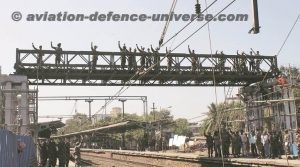
The necessity for construction of Foot over Bridges (FOB) in Mumbai emerged due to stampede tragedy an Elphinstone Road Railway Station on 29 Sep 17 where 22 innocent civilians lost their lives. Indian Army was tasked to undertake construction of three FOBs for Indian Railways in Mumbai as an Aid to Civil Authority for safe and smooth functioning of essential services, vital for state functioning. These FOB’s were required to be constructed by 31 Jan 18 and three locations at Elphinstone Road Railway Station, Curry Road Railway Station and Ambivali Railway Station were identified by the govt. Elphinstone Bridge was given on 26 Oct 17 and for the rest two Bridges on 04 Nov 17 with Bombay Engineer Group and Centre being overall task executing agency.The Task entailed 240 feet multiple span Bridge at Elphinstone Bridge site, 60 feet Bridge at Ambivali and 100 feet Bridge at Curry Road Bridge site along with Stair Cases and Canopy.
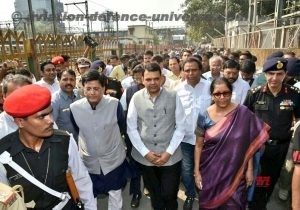
The construction of the FOBs was divided into four main stages which included construction of pile foundation, fabrication and erection of piers, launching of bridge over piers and erection of ancillary’s i.e. Stair Cases, Canopy and Protective wire mesh. Heavy traffic on routes and limited working hours, high voltage wiring, restricted space and difficulty of construction were some of the challenges which were faced. One of the Major requirements of the railways FOB was provision of a canopy over the Bridge which necessitated changes in the bridge design. The additional load due to wind factor was worked out. Garden Reach Ship Builders and Engineers was approached and strengthening of the bridge was carried out using additional chord reinforcement. The roof of the canopy was designed in a staggered pattern thus reducing the wind loads acting on the bridge. This was for the first time that the Bailey bridge had been provided with a canopy anywhere in the world.
Special Services
Bombay Sappers have also been called upon to carry out special services viz.
- Maintenance of electrical services during a strike at Obra
- Maintenance of electrical services during Pirand in 1972
- Street patrolling during communal riots in Aligarh
- Search for the black box of the ill fated Vayudoot Aircraft at Ujjaini Dam in 1990
- Handling of heavy equipment during the Bombay Dockyard workers strike in 1989
- Unexploded bombs disposal by the Bomb Disposal units in Madras 1997
- Assistance to police post Bombay blasts 1993 and Shells destruction at Ghaziabad in 2005.




























































































































